Baroque chess is a chess variant invented in 1962 by Robert Abbott. In 1963, at the suggestion of his publisher, he changed the name to Ultima, by which name it is also known. Abbott later considered his invention flawed and suggested amendments to the rules, but these suggestions have been substantially ignored by the gaming community, which continues to play by the 1962 rules. Since the rules for Baroque were first laid down in 1962, some regional variation has arisen, causing the game to diverge from Ultima.

DVONN is a two-player strategy board game in which the objective is to accumulate pieces in stacks. It was released in 2001 by Kris Burm as the fourth game in the GIPF Project. DVONN won the 2002 International Gamers Award and the Games magazine Game of the Year Award in 2003.
The GIPF Project is a series of seven abstract strategy games by designer Kris Burm.

GIPF is an abstract strategy board game by Kris Burm, the first of seven games in his series of games called the GIPF Project. GIPF was recommended by Spiel des Jahres in 1998.

TAMSK is a two-player board game designed by Kris Burm. It was originally published in 1998 as the second game in the GIPF Project series of abstract strategy games, although it was later dropped from the series in favor of TZAAR. Players move sand hourglass timers and drop plastic rings around spaces on a hexagonal board in an attempt to limit their opponent's moves. Each player starts the game with 32 rings, and the player with the fewest remaining rings at the end of the game is the winner. The game is unique among the GIPF Project games in having time as a central game component, and the manner in which time is used is possibly unique among board games in general.

ZÈRTZ is the third game in the GIPF Project of seven abstract strategy games. The game features a shrinking board and an object that promotes sacrifice combinations. It is impartial: since neither player owns on-board pieces, maintaining the initiative is of fundamental importance.

YINSH is an abstract strategy board game by game designer Kris Burm. It is the fifth game to be released in the GIPF Project. At the time of its release in 2003, Burm stated that he intended it to be considered as the sixth and last game of the project, and that the game which he had not yet released, PÜNCT, would be logically the fifth game. However, the series was later expanded to seven games with the release of LYNGK.

PÜNCT is a two-player strategy board game. It is the sixth release in the GIPF project of seven abstract strategy games, although it is considered the fifth game in the project. It was released in 2005. PÜNCT won the Games Magazine Best Abstract Strategy game for 2007.
Lotus is a board game for two to four players, developed by Dominique Tellier and published by Ravensburger Spieleverlag. The objective of the game is to move one's pieces off the board before the other players. The game board is hexagonal, and contains a large image of a Chinese dragon in the middle, as well as a Chinese character in each board position.
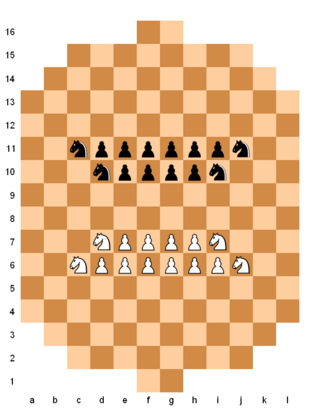
Camelot is a strategy board game for two players. It was invented by George S. Parker late in the 19th century, and was one of the first games published by Parker Brothers, originally under the name Chivalry.
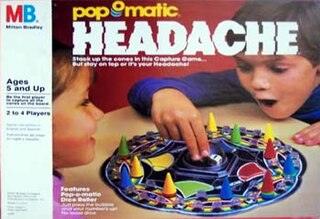
Headache is a board game in which two to four players take turns moving cone-shaped pieces around a board until one player succeeds in capturing every other piece on the board.
Cinc camins is a two-player abstract strategy game from northern China. Although played by children, there is a complexity and uniqueness to the game that adults can appreciate. The game may be related to the gonu (kono) games of Korea. These games use small boards, and have unique capturing rules.
Brax is a two-player abstract strategy board game. It was invented in 1889 in America by Frederic B. Denham of New York City. The board design is unique. The players move their pieces along paths on the square board; each path is one of two colors. A piece can move one or two spaces in a turn depending upon whether it matches the color of the path. Players attempt to capture each other's pieces.
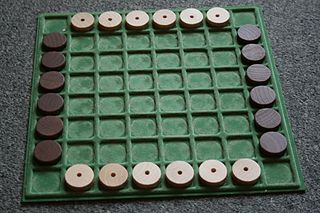
Lines of Action is an abstract strategy board game for two players invented by Claude Soucie. The objective is to connect all of one's pieces into a single group. The game was recommended by the Spiel des Jahres in 1988.
Dala is a two-player abstract strategy board game from Sudan, and played especially by the Baggara tribes. The game is also called Herding the Cows. It is an alignment game with captures similar to that of the game Dara. Players first drop their pieces onto the board, and then move them orthogonally in an attempt to form 3 in-a-rows which allows a player to capture any of their opponent's piece on the board.
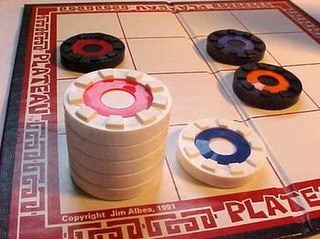
Plateau is a two-player abstract strategy board game invented by Jim Albea.

Dameo is an abstract strategy board game for two players invented by Christian Freeling in 2000. It is a variant of the game draughts and is played on an 8×8 checkered gameboard.

Hostage chess is a chess variant invented by John A. Leslie in 1997. Captured pieces are not eliminated from the game but can reenter active play through drops, similar to shogi. Unlike shogi, the piece a player may drop is one of their own pieces previously captured by the opponent. In exchange, the player returns a previously captured enemy piece which the opponent may drop on a future turn. This is the characteristic feature of the game.
This glossary of board games explains commonly used terms in board games, in alphabetical order. For a list of board games, see List of board games; for terms specific to chess, see Glossary of chess; for terms specific to chess problems, see Glossary of chess problems.
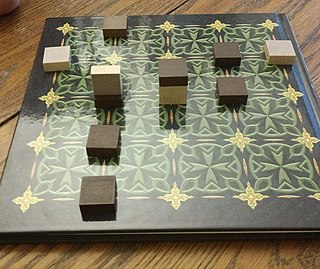
Tak is a two-player abstract strategy game that first existed fictionally within Patrick Rothfuss's fantasy trilogy, The Kingkiller Chronicle, before being brought to life by James Ernest in collaboration with Rothfuss, and published by Cheapass Games in 2016. In 2021, Tak was incorporated as an event in the international Mind Sports Olympiad.
















